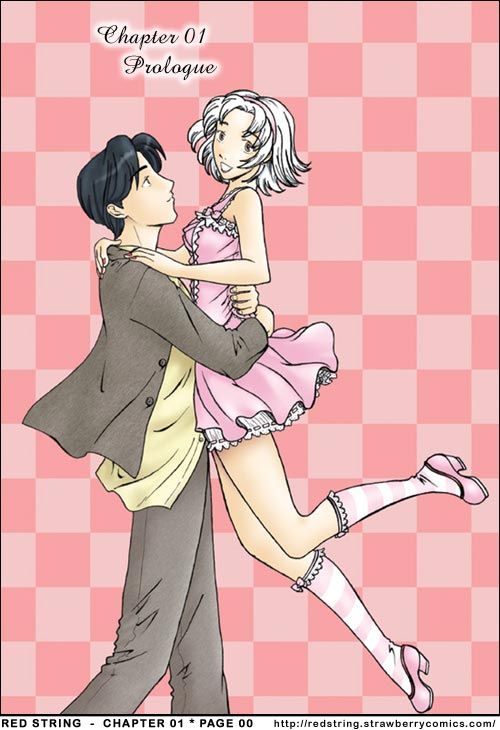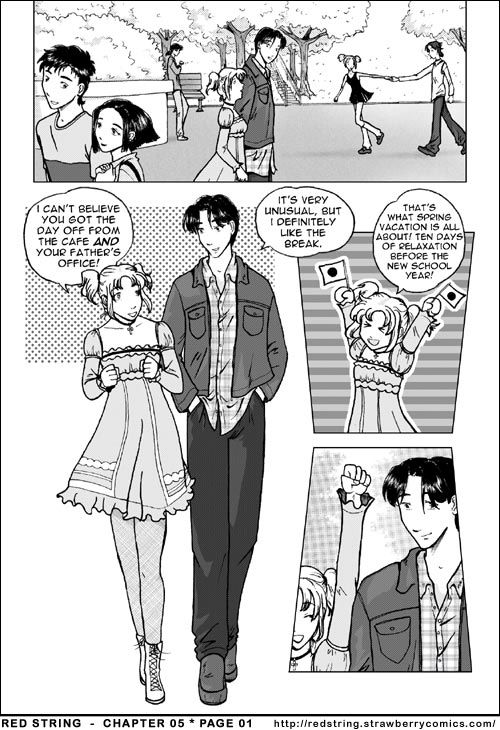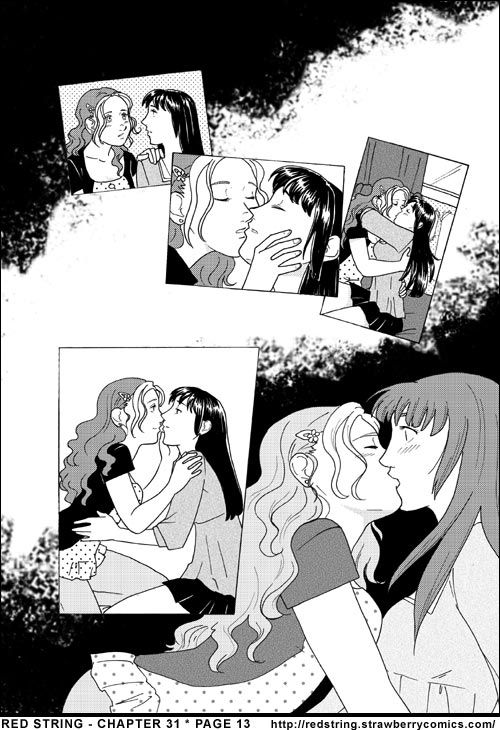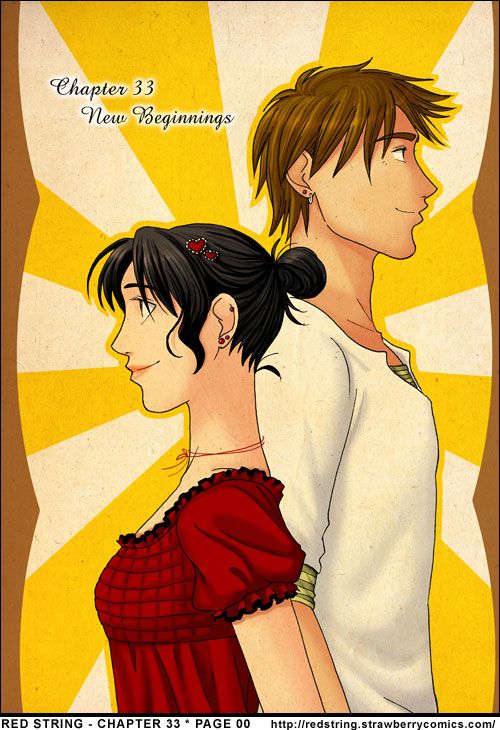The interesting thing about Gina Biggs is not that she is the creator of a shoujo manga webcomic. Lots of people do that.
What’s interesting is that she has kept her comic, Red String, going continuously for six years, growing the audience as she goes; that Dark Horse, a publisher better known for manly manga than for quiet romances, published the first three volumes; and that she is a key member of Strawberry Comics, a collective of like-minded female creators who promote romance comics online.
While almost all the early global manga creators signed contracts with Tokyopop, Biggs chose to put her comic online and build an audience that way. After three volumes she is now self-publishing Red String and she says she makes about the same amount of money and works about as hard as when she was with Dark Horse. And best of all, she looks like she is having fun.
Brigid Alverson: Tell me first about your webcomic, Red String.
Gina Biggs: The theme at its most basic is the exploration of love in all its forms and the path to growing up. Expanding on that, the red string of fate is a Chinese and Japanese myth that says that two lovers destined to marry are bound together by a red string. As they go through life the string becomes shorter and shorter until the day that they two are brought together.
Brigid: Why did you choose the Japanese setting and manga-influenced style?
Gina: My early influences in comics were actually X-Men, Conan, and other very male oriented corporate comics. However, as I hit my mid-teens I discovered shoujo manga and was inspired by the fact that women were creating comics. I was also impressed with the idea that there were comics out there focusing on romance and I think these factors started to shift my artistic influences. The Japanese setting, well, I really enjoy all sorts of folk tales and mythology so when I came across the red string of fate, I really liked that romantic notion. I wanted to write something questioning fate or making your own path. Since it was a Japanese myth, I decided to place the setting there.
Brigid: When the comic launched, manga was still a fairly new phenomenon and you must have been one of only a handful of non-Japanese artists working in that style. How did you feel about that?
Gina: I was definitely a little intimidated. I encountered a lot of resistance and backlash from folks at conventions early on. The American-style comic readers claimed I was just drawing what was popular and that they weren't real comics, and the manga readers screamed that it wasn't real manga and I was a poser from trying to draw it. Of course, writing romance stories didn't help at the time either since shoujo manga wasn't nearly as popular as it is now. However, I kept pushing forward and learned to just turn a blind eye to them and concentrate on people who were willing to give me a shot. Now that manga is much more normalized a lot more people are willing to give you a chance. It's great to see people trying new things especially for artists who aren't illustrating big name titles for the big two.
Brigid: How have you evolved, as an artist and writer, as you worked on the story?
Gina: I know for a fact that my art has evolved by leaps and bounds since I first started Red String six years ago. In the past year even more so since I started taking Figure Drawing Classes. The anatomy and poses have become more natural and easier to do on demand. As a writer I have become much more conscious of dialogue as I have become more comfortable with the characters. There were a lot of places early on where the writing was a bit stiff. I think I'm doing much better on that these days.
Brigid: How has the story evolved?
Gina: Originally the story started out as a one-shot about two kids meeting by chance and finding out that it might be a bit more than mere chance involved. When I decided to turn Red String into a webcomic series it started branching out with more characters and the focus turned toward exploring all sorts of love.
Brigid: What sort of feedback have you gotten from your readers? Have they commented on (or disagreed with) story twists? Does the feedback affect your writing?
Gina: I have generally received very positive feedback from readers. Sometimes people disagree with the story lines, but usually it turns out that a chapter or so later all is revealed and readers see the bigger picture. There was only a small handful of readers who did not like the revelation of lesbians being a part of the story. Soapboxes and eternal hellfire were cited a couple times, but generally I get some of the biggest compliments on that sub-plot. Feedback does indeed affect my writing sometimes. There have been some instances were I have seen their point or realized I had not addressed certain issues and then I go back in to my summaries for future chapters to make sure I cover it. Of course, I still continue to write the story as I wish to write it, but I think if I were to ignore the feedback completely that would be a big mistake.
Brigid: Is there an end in sight for the series, or do you think you will continue to add stories?
Gina: Right now the series is planned for forty-nine chapters, so I have about two years left to go. However, I have left it open enough in case I decided to continue on with it.
Brigid: Red String is formatted like a print manga. Had you always intended it to be a print comic, or did you think of it as primarily a webcomic?
Gina: Since I had only previously worked with print comics it was the only format I was comfortable with drawing. I have discovered since then that I have a decent handle on pacing for a story told this way. The beat for my four panel work seems to still be missing something.
Brigid: You seem to have a number of different income streams from the site‹donations, ads, sale of wallpapers, and presumably, print sales. How did these evolve, and how important is each of them to the overall picture?
Gina: Donations and book sales have been hugely important to keeping me working on comics as a full-time job. I have tried different things over time, but I have found that donations with incentives, books, and more recently, t-shirts are an important thing for a webcomic artist. Lesser so are the wallpapers, prints, and other sorts of merchandise. The money from ads are equally important to the overall picture in that I throw that money right back into advertising for my own site so the more ad money, the more exposure I can afford.
Brigid: Dark Horse published the first three volumes of Red String. What was it like working with them?
Gina: The folks over at Dark Horse are a great bunch. They really are a friendly lot and my editor was always working hard to help me out. I actually went through several cover designs before we got something that they were sure would work for me. I really learn a lot about cover design working with them.
Brigid: How did having a print comic change your audience and your own perception of your work?
Gina: When Dark Horse approached me I had just recently put together a print edition on my own for Red String through a print-on-demand place. Once it was published by Dark Horse it really took the leap from small book sold only at conventions by an unknown to a chain bookstore book with much more recognition. I found folks passing by my booth at conventions would stop and give me a look having recognized the cover. Previous to Dark Horse it was a much harder sell. As for my own perception, I think it definitely helped me feel more confident about my work.
Brigid: Why did you and Dark Horse decide to part ways?
Gina: It was a mutual break up. I realized that I could make enough money with Red String for myself, but not for myself and a big corporation. About the same time, Dark Horse was realizing the same thing.
Brigid: How is producing your own print comic different from working with a publisher—what are the benefits and disadvantages?
Gina: There's more work involved in working with a printer, but I don't think that's really a problem. The disadvantage is definitely having to front the print money myself. However, there are a lot less costs involved with printing the books myself, so there are a lot less books I have to sell to break even. Dark Horse did do some marketing for the book (an ad in Previews, for instance), but I found that I was working just as hard at the marketing aspect as when I was with them. I never really expected that being with a large publisher would mean people would instantly find my work. Knowing that has been a big key to continually growing my readership.
Brigid: What exactly is Strawberry Comics? Who are the members?
Gina: Strawberry Comics is a collective with all-female members creating stories that focus on love and romance. It is designed to promote women comic creators. Our members include myself, Robin Edwards (creator of Cardboard Angel), Amy Stoddard (creator of Patches), Angi Chan (creator of Devil's Cake), Louisa Roy (creator of Velharthis and collaborator with me on Erstwhile), and Elle Skinner (creator of The Littlest Elle and also a collaborator on Erstwhile).
Brigid: What are the criteria for joining?
Gina: Though we are not currently accepting new members, we generally look for creators who focus character driven stories and some exploration of love.
Brigid: Does the group prefer a single type of comics?
Gina: Oh no! While a lot of our members lean toward manga influenced art, we like diversity in style. Elle, for instance, has fantastic whimsical art very far from what anyone would consider manga. Louisa likes to write historical-fiction romances and fairy tales while Robin enjoys writing coming-of-age and adult dramas. We definitely like to see variety.
Brigid: What was your goal in forming Strawberry Comics?
Gina: My goal when starting Strawberry Comics was to get the word out on talented female comic creators. Even though I knew at an early age that I wanted to create comics, it wasn't until my mid-teens that I discovered through shoujo manga that women could do it, too. That was definitely an influence on creating the collective.
Brigid: In late May, you made a change in the way you handle print comics. What happened, and why did you make the change?
Gina: To be honest, I was sort of a one-woman show in terms of handling Strawberry Comics. I did everything from putting the books together for print, marketing, sales, invoices, and shipping of books. It became quite overwhelming and since the fall of Wowio, money became a big issue. Originally, the digital books we distributed with them funded the printing of their books. I no longer had the money to front the printing costs for everyone's books. We are continuing to publish books, but each artist now prints and sells their own book titles. Now you support the members more directly by purchasing their books and merchandise directly through them.
Brigid: Are you working on any other projects, or do you have new plans for the future?
Gina: I am currently working on a series titled Erstwhile with Elle Skinner and Louisa Roy. It is adaptations of the lesser known Grimm Brothers' fairy tales into full color comics. Currently we have three issues out and are working on the fourth.





